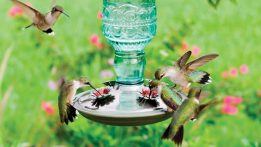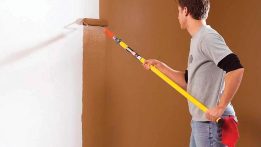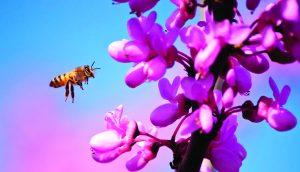 As the springtime clouds of yellow pollen fill the air, our skies also fill with several wildlife species, including birds, bees, butterflies and bats. Spring is an important time of year for wildlife, as it’s when many of them are raising their young. Many species also become more active this time of year, meaning we are more likely to encounter them as we go about our daily business. Below are some great tips for coexisting with birds, insects and bats this spring. By following a few simple steps, you can make a difference for wildlife and help prevent wildlife conflicts in your neighborhood.
As the springtime clouds of yellow pollen fill the air, our skies also fill with several wildlife species, including birds, bees, butterflies and bats. Spring is an important time of year for wildlife, as it’s when many of them are raising their young. Many species also become more active this time of year, meaning we are more likely to encounter them as we go about our daily business. Below are some great tips for coexisting with birds, insects and bats this spring. By following a few simple steps, you can make a difference for wildlife and help prevent wildlife conflicts in your neighborhood.
Make a difference for nesting birds!
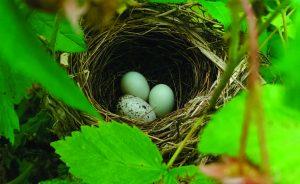 Spring is a time when many bird species are building nests and raising their young. They are particularly vulnerable during this time, and they could use your help to ensure that their chicks fly off successfully at the end of the season. Here are three simple steps that you can take to be a good neighbor to nesting birds.
Spring is a time when many bird species are building nests and raising their young. They are particularly vulnerable during this time, and they could use your help to ensure that their chicks fly off successfully at the end of the season. Here are three simple steps that you can take to be a good neighbor to nesting birds.
First, be careful with your landscaping. Our springtime yard cleanup rituals can have big implications for wildlife. As we trim our hedges, cut back tree limbs, and mow our lawns, it is important to consider our impacts to wildlife. Be sure to check tree branches and hedges for bird nests or other signs of wildlife before you trim.
Second, give birds space. Having a bird nest near your home can be a wonderful wildlife viewing experience for you and your family. Species like Carolina wrens may even choose to nest in small nooks and crannies of your porch, or other similar spots, bringing nature right to your doorstep. However, it can be possible to love nesting birds too much. Be sure to view the birds and their nest from a respectful distance and avoid disturbing nesting birds and their young as much as possible during this time.
Finally, keep cats indoors! One of the biggest threats to nesting songbirds is our own furry friend, the domestic cat. Outdoor cats kill billions of birds every year in the United States. Keeping your kitties indoors is the best and safest course of action for your pet and for our native wildlife.
Be aware of nesting birds of prey.
 Birds of prey, also called raptors, include hawks, owls, ospreys and kestrels. These birds can be very protective of their nests and young. They can become defensive during nesting season and are known to dive at people who get too close. To avoid conflicts with birds of prey during nesting season, be sure that you are always aware of your surroundings. Raptors vocalizing, flying low or circling above a tree or other structure could be an indication you are too close to a nest. It is best to avoid areas near raptor nests if possible. If you must go through the area where the birds have been acting defensively, carry an open umbrella, wear a hard hat, or temporarily erect a shade structure to obstruct the birds’ view of people and pets. You can also prevent issues with nesting raptors by eliminating attractants that may attract prey, such as rodents, to your yard. Items like unsecured garbage, bird seed, and pet food are common household attractants that may entice prey species onto your property.
Birds of prey, also called raptors, include hawks, owls, ospreys and kestrels. These birds can be very protective of their nests and young. They can become defensive during nesting season and are known to dive at people who get too close. To avoid conflicts with birds of prey during nesting season, be sure that you are always aware of your surroundings. Raptors vocalizing, flying low or circling above a tree or other structure could be an indication you are too close to a nest. It is best to avoid areas near raptor nests if possible. If you must go through the area where the birds have been acting defensively, carry an open umbrella, wear a hard hat, or temporarily erect a shade structure to obstruct the birds’ view of people and pets. You can also prevent issues with nesting raptors by eliminating attractants that may attract prey, such as rodents, to your yard. Items like unsecured garbage, bird seed, and pet food are common household attractants that may entice prey species onto your property.
Plant native for pollinators.
 Are you considering some changes to your yard this spring? Would you like to attract native pollinators like bees and butterflies to your property? Try incorporating native plants into your landscaping. Native plants are adapted for an area’s soil and climate. Native species have adapted their lifecycles along with them, so they are the best sources of food and shelter for native species. For instance, more than 500 species of Florida native caterpillars can live in a native oak tree, while only three species can survive in a nonnative Chinese tallow tree. One easy-to-care-for native plant that is likely to attract pollinators to your yard is milkweed. These lovely flowers are also the host plant for monarch butterflies. You and your family can enjoy watching butterflies visit the plants, and if you’re lucky, they may lay eggs, which will hatch into many tiny striped caterpillars.
Are you considering some changes to your yard this spring? Would you like to attract native pollinators like bees and butterflies to your property? Try incorporating native plants into your landscaping. Native plants are adapted for an area’s soil and climate. Native species have adapted their lifecycles along with them, so they are the best sources of food and shelter for native species. For instance, more than 500 species of Florida native caterpillars can live in a native oak tree, while only three species can survive in a nonnative Chinese tallow tree. One easy-to-care-for native plant that is likely to attract pollinators to your yard is milkweed. These lovely flowers are also the host plant for monarch butterflies. You and your family can enjoy watching butterflies visit the plants, and if you’re lucky, they may lay eggs, which will hatch into many tiny striped caterpillars.
Prepare your home for bat maternity season.
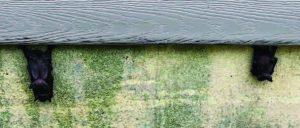 Bat maternity season begins on April 15, and from then through August 15, it is illegal to exclude bats from their roost. During maternity season, bats gather to give birth and raise their young, and if they are blocked from their roosts, young bats could become trapped and die. That’s why it is important to check your home for bats and for any potential entry points for bats now and to take care of any issues on your property before maternity season begins. Check your home and other buildings for any small cracks or holes, and keep in mind that bats can fit in the tiniest of spaces. If bats are present, the entry/exit holes may have light brown staining around them, or you may see bats or their droppings. You can also help these flying mammals by preserving natural roost sites, including trees with cavities and peeling bark. Dead fronds left on palms can also provide roosting spots for bats, or you can help by erecting a bat house.
Bat maternity season begins on April 15, and from then through August 15, it is illegal to exclude bats from their roost. During maternity season, bats gather to give birth and raise their young, and if they are blocked from their roosts, young bats could become trapped and die. That’s why it is important to check your home for bats and for any potential entry points for bats now and to take care of any issues on your property before maternity season begins. Check your home and other buildings for any small cracks or holes, and keep in mind that bats can fit in the tiniest of spaces. If bats are present, the entry/exit holes may have light brown staining around them, or you may see bats or their droppings. You can also help these flying mammals by preserving natural roost sites, including trees with cavities and peeling bark. Dead fronds left on palms can also provide roosting spots for bats, or you can help by erecting a bat house.
For more information, visit MyFWC.com. If you’re experiencing conflicts with wildlife or have questions, contact your FWC regional office at 850-265-3676. ![]()
Jamie Rager
Florida Fish and Wildlife Conservation Commission



